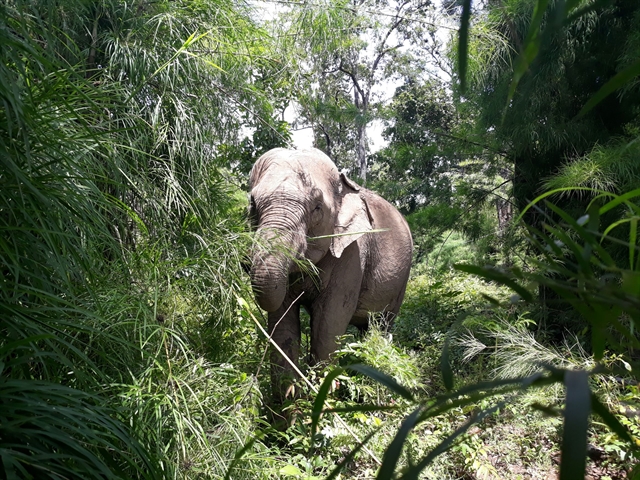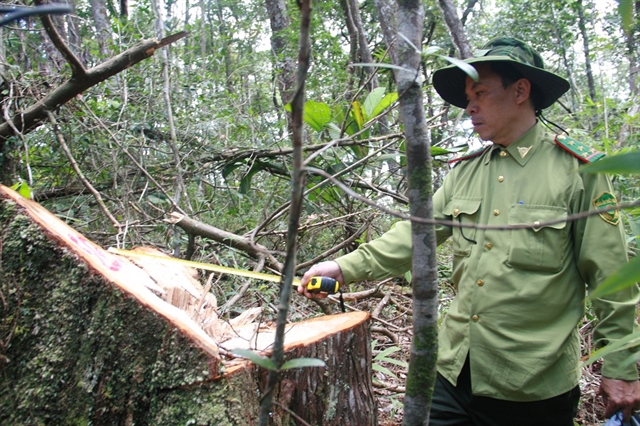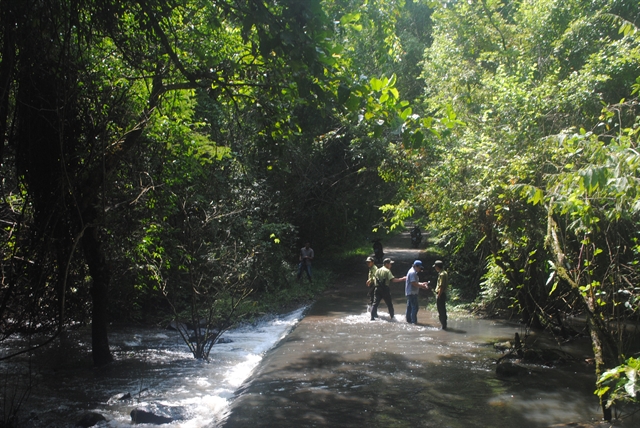Conflict between people and animals is one of the main threats to the long-term survival of some of the world’s, and Việt Nam’s, most emblematic species, a new report from WWF and the UN Environment Programme (UNEP) has warned.

An elephant is found living in a jungle in the central highlands province of Đắk Lắk Conflict between people and animals is one of the main threats to the long-term survival of some of the world’s most emblematic species. Photo courtesy of AnimalsAsia
These types of conflict often lead to people killing animals in self-defence, or as pre-emptive or retaliatory killings, which can drive species to extinction, the A future for all-the need for human-wildlife coexistence report says.
Việt Nam’s wild elephants, for example, are known for raiding farms for food and water. Over 100 hectares of crops, five temporary houses, and several hundred cashew and rubber trees were damaged by wild elephants between 2016 and 2020.
Though no cases of human casualties have been recorded in recent years, at least two cases of juvenile elephants being injured by illegal snares have occurred.
According to the WWF, there is still significant concern for the safety of wild elephants due to ongoing habitat loss. Stopping land conversion along the elephants’ movement corridors and restoration of their habitat are strongly recommended for a safer environment for both people and elephants.
The report notes that though people the world over reap the benefits of maintaining flourishing wildlife populations catastrophic impacts such as injury and death and the loss of property and livelihoods place a strain on those who live alongside wildlife.
WWF-Viet Nam has been working with Yók Đôn National Park and Đắk Lắk Elephant Conservation Centre to conduct a Human-Elephant Conflict (HEC) assessment and has developed a five-year HEC management strategy to run from 2021 to 2025.
The organisation has also supported the establishment and operation of a community-based management group in nearby Drang Phok Village. This includes staff from Yók Đôn National Park, Elephant Conservation Centre and villagers in four of the most-impacted communes who were trained on HEC mitigation strategies.
The WWF-Việt Nam, in cooperation with Đắk Lắk Elephant Conservation Centre also launched a GPS supervision project on wild elephant herds found in the province in 2019. This focuses on the possibility of GPS applications for tracking and monitoring the movements of wild elephants.
Furthermore, Đắk Lắk has attempted to protect its elephant population through a scheme to compensate people after crop losses due to elephant damage.
However, lessons learned from other countries suggest that this kind of compensation should be replaced by an insurance scheme for local communities that have been affected by elephants.
At least four Asian elephant herds, comprising 60-70 elephants, live in the provincial Yok Đôn National Park.
Đắk Lắk hosts the largest habitat of the endangered Asian elephant although WWF-Việt Nam says that at least 25 elephants had died since 2009, 75 per cent of which were calves.
According to the report, however, more needs to be done to reduce instances of human-wildlife conflict. It notes that the relationship between humans and wildlife is imperative to meeting many of the SDGs.
“If human-wildlife conflict is not adequately addressed by the international community, WWF believes it will have a considerable negative impact on countries’ ability to meet the majority of the SDGs,” says Margaret Kinnaird, Global Wildlife Practice Leader at WWF International.
Kinnaird also stresses that the impacts of human-wildlife conflict continue to be overlooked by policymakers and this needs to change.
“If the world is to have a chance of meeting the SDGs by the 2030 deadline, human-wildlife conflict must be explicitly included in SDG implementation plans, as well as at the heart of the Convention on Biodiversity’s new framework.”
The report says that completely eradicating human-wildlife conflict is not possible but that well-planned, integrated approaches to managing and reducing conflicts can lead to a form of coexistence between people and animals.

A ranger inspects an area of forest in central Việt Nam. Photo courtesy of Quảng Nam sub-department of Forest Protection
The report says this can have a number of benefits for local communities.
Reducing human-wildlife conflict can lead to opportunities and benefits not only for biodiversity and impacted communities, but for society, sustainable development, production, and the global economy at large, it says.
“Within a human lifetime, we have already seen extraordinary and unparalleled changes to our planet. Global wildlife populations have fallen an average of 68 per cent since 1970,” says Margaret Kinnaird, Global Wildlife Practice Leader at WWF International.
“Human-wildlife conflict, in combination with other threats, has driven significant decline of species that were once abundant, and species that are naturally less abundant have been pushed to the brink of extinction. Unless urgent action is taken, this devastating trend will only worsen, wreaking detrimental and, in some cases, irreversible impacts on ecosystems and biodiversity.”

A ranger team patrol in forest of Nam Cát Tiên National Park in the central highlands of Lâm Đồng Province. VNS Photo Công Thành
Susan Gardner, Director of UNEP’s Ecosystems Division, echoed a similar sentiment.
“This report is a clarion call to elevate the problem of human wildlife conflict and give it the attention it deserves in national and international processes,” she says.
“It is a call for the adoption of approaches that identify and address the deeper, underlying causes of conflict while developing systemic solutions with affected communities as active and equal participants in the process,” she goes on.
She is, however, optimistic about the future.
“As demonstrated in many of the case studies in this report, coexistence,” she says, “is both possible and attainable.”